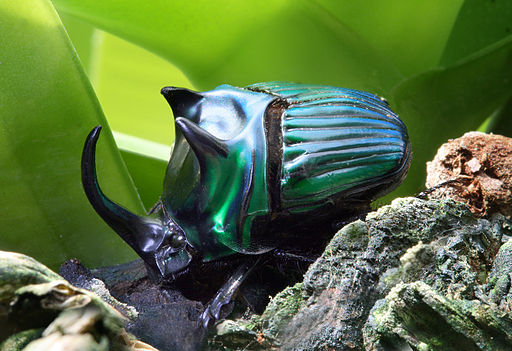Superregnum: Eukaryota
Cladus: Unikonta
Cladus: Opisthokonta
Cladus: Holozoa
Regnum: Animalia
Subregnum: Eumetazoa
Cladus: Bilateria
Cladus: Nephrozoa
Cladus: Protostomia
Cladus: Ecdysozoa
Cladus: Panarthropoda
Phylum: Arthropoda
Subphylum: Hexapoda
Classis: Insecta
Cladus: Dicondylia
Subclassis: Pterygota
Cladus: Metapterygota
Infraclassis: Neoptera
Cladus: Eumetabola
Cladus: Endopterygota
Superordo: Coleopterida
Ordo: Coleoptera
Subordo: Polyphaga
Infraordo: Scarabaeiformia
Superfamilia: Scarabaeoidea
Familia: Scarabaeidae
Subfamilia: Scarabaeinae
Tribus: Phanaeini
Genus: Oxysternon
Species: Oxysternon conspicillatum
Name
Oxysternon conspicillatum Weber, 1801
Synonyms
Oxysternon oberthuri Olsoufieff, 1924
References
Paul Schoolmeesters (September 1st, 2006) World Scarabaeidae Database. In Species 2000 & ITIS Catalogue of Life: 2007 Annual Checklist (FA Bisby, YR Roskov, MA Ruggiero, TM Orrell, LE Paglinawan, PW Brewer, N Bailly, J van Hertum, eds) (2007). Species 2000 & ITIS Catalogue of Life: 2007 Annual Checklist. Digital resource at www.catalogueoflife.org/annual-checklist/2007/. Species 2000: Reading, U.K.
Oxysternon conspicillatum is a species of dung beetle. It is widespread and common in both evergreen and deciduous forests of Central America and northern South America, and generally sticks to lowland, dry tropical and bamboo forests. The larvae feed on fungi, decaying organic matter, and other organic materials found in dung balls or carrion.[1][2][3]
Both male and female beetles are hard-shelled with an iridescent blue-green color on their skin. The species exhibits some sexual dimorphism; males have large black horns and spikes on their shells while females' shells are flat. Male O. conspicillatum also tend to be larger than their female counterparts.[3]
Oxysternon conspicillatum has been studied as a potential source for antimicrobial agents, with the possible use of its host defense peptides in the development of new antibiotics.[1]
A male Oxysternon conspicillatum beetle
Females lack the large horn
References
Segovia, LJT; Ramírez, GAT; Arias, DCH; et al. (Nov 2017). "Identification and characterization of novel cecropins from the Oxysternon conspicillatum neotropic dung beetle". PLOS ONE. 12 (11): e0187914. doi:10.1371/journal.pone.0187914. PMC 5706684. PMID 29186139.
Chamorro, William; Marin-Armijos, Diego; Asenjo, Angélico; Vaz-De-Mello, Fernando Z. (2019). "Scarabaeinae dung beetles from Ecuador: a catalog, nomenclatural acts, and distribution records". ZooKeys (826): 1–343. doi:10.3897/zookeys.826.26488. PMC 6405737. PMID 30858752.
"Oxysternon conspicillatum". GBIF. Retrieved 2019-03-19.
Retrieved from "http://en.wikipedia.org/"
All text is available under the terms of the GNU Free Documentation License


